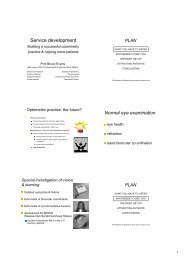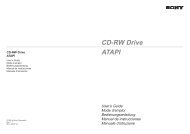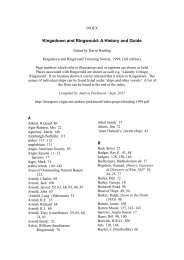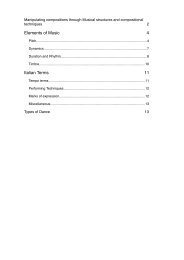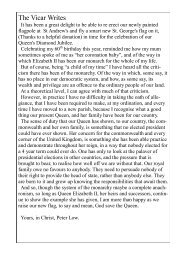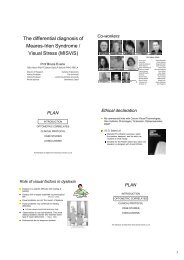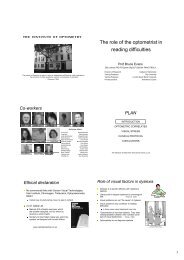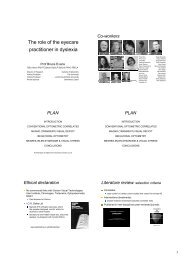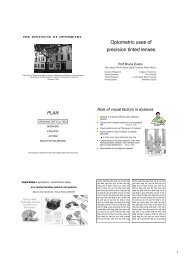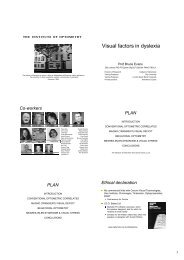Danish Optometric & CL conference, 2013
Danish Optometric & CL conference, 2013
Danish Optometric & CL conference, 2013
Create successful ePaper yourself
Turn your PDF publications into a flip-book with our unique Google optimized e-Paper software.
PLAN<br />
BACKGROUND<br />
WHY<br />
HOW<br />
CON<strong>CL</strong>USIONS<br />
Full handout from:<br />
www.bruce-evans.co.uk<br />
DIS<strong>CL</strong>OSURE<br />
• Paid lectures & KOL/product feedback<br />
programmes for<br />
– Johnson & Johnson Vision Care<br />
• Gratefully acknowledge funding for attendance today<br />
– Cibavision<br />
– Coopervision<br />
– Cerium Visual Technologies<br />
• Lecture content always my own<br />
Introduction<br />
• International survey of 100,000 fits<br />
for 2005-2009...<strong>Danish</strong> data<br />
– Teenagers (13-17): ~11%<br />
– Children (6-12): ~2% Efron, Morgan, Woods (2011)<br />
PLAN<br />
BACKGROUND<br />
WHY<br />
HOW<br />
CON<strong>CL</strong>USIONS<br />
Q: What is the top reasons for adults wanting <strong>CL</strong>?<br />
Main reason (Gupta & Naroo, 2006)<br />
1. Cosmetic<br />
2. Sports<br />
3. Convenience (e.g., rain, cooking)<br />
4. Better vision<br />
5. Hate glasses<br />
6. Optical (e.g., anisometropia)<br />
7. Medical (e.g., keratoconus)<br />
8. Other<br />
31%<br />
8%<br />
34%<br />
5%<br />
3%<br />
[not asked]<br />
2%<br />
17%<br />
Bowden & Harknett (2006)<br />
1
Cosmesis<br />
• <strong>CL</strong> better than specs for cosmesis<br />
• Q: in which decade of your life did you<br />
worry most about your appearance?<br />
– 1-10 years<br />
– 11-20 years<br />
– 21-30 years<br />
– 31-40 years<br />
– 41-50 years<br />
Comprehensive school (Neath, South Wales) student council issued a statement denying the school had a bullying problem whilst<br />
headteacher Alun Griffiths said "a range of strategies" was used to tackle bullying claims. [More |More| More]. In November 2004 the<br />
parents of Laura Rhodes demanded new laws to force schools to record bullying. [More] In April 2005 Laura Rhodes' parents prepare to<br />
take legal action over the death of their daughter. [More] An inquest in May 2005 hears allegations of bullying at Cefn Saeson<br />
Comprehensive School, Neath. [More |Suicide verdict]<br />
September 2004: 14-year-old Amy Rose Tipton, of Kidderminster, Worcestershire, died after taking an overdose of antidepressants. She<br />
was described as a high achiever at school, a beautiful, sensitive child who aspired to be a dancer. Police said they were investigating the<br />
possibility that she was being bullied at school. [More] [Coroner's verdict More]<br />
October 2004: An inquest hears how Jamie Sell, a pupil at Cantonian High School in Fairwater, Cardiff, hanged himself a few days before<br />
his 18th birthday after being taunted by bullies. "The school takes any issue of bullying very seriously and has an anti-bullying policy in<br />
place" commented head teacher Lois Spargo. [More]<br />
April 2005: 12-year-old Nathan Jones hangs himself after being tormented by bullies at King’s Wood School, in Harold Hill, Romford,<br />
Essex. Nathan was a school council representative who acted in school plays and raised money for the tsunami appeal. [More| More]<br />
April 2005: 14-year-old Shaun Noonan from Ellesmere Port, Cheshire hangs himself after a long period of bullying including being<br />
headbutted, thrown into a ditch, having an earring pulled out and a 'happy slapping' incident recorded on mobile phones by youths at<br />
Sutton High School. [More| More]<br />
May 2005: 15-year-old Anna Marie Averill, a pupil at Hillcrest School, in Bartley Green, Birmingham, kills herself after months of bullying.<br />
[More| More]<br />
Near suicides<br />
May 2005: 17-year-old Kirsty Jessen was bullied continuously since the age of 4 because she suffers from alopecia (hair loss). She thought<br />
often about committing suicide. [More]<br />
25 June 2003: 9-year-old Jessica O'Connell kept a two-year diary of events in which she describes being hit, verbally abused and held<br />
down in a swimming pool. Jessica thought about killing herself because of two years of bullying by a classmate which the school (St<br />
Wilfrid's Roman Catholic School in Ripon, North Yorkshire) repeatedly failed to deal with - the school said that her tormentor could only<br />
be suspended because the bullying was "not serious enough" for greater punishment. Jessica wrote "To mummy, I wish I was dead so I<br />
don't have to suffer any Cosmesis<br />
more pain. I love you." Jessica lived to tell the tale - but only just. [More| More]<br />
August 2003: 12-year-old Aimee Reynolds felt suicidal and was withdrawn from Paignton Community College, Devon, because of<br />
persistent bullying [More]<br />
19 September 2003: Leighann Turner, 14, took an overdose of painkillers after two years of bullying at Holyrood High, Edinburgh, Scotland<br />
[More]<br />
Serious assaults and deaths<br />
19 May 2005: 16-year-old Becky Smith is left unconscious after a slap attack by fellow school pupils from Plant Hill High School in Blackley,<br />
Manchester. The slap attackers Cawson record the et assault al. on (2000, their mobile NSPCC) phone and distribute the video at school. [More| Josh Belluardo case]<br />
27 November 2000: 10-year-old Damilola Taylor is attacked on his way home from school and bleeds to death in a stairwell in south<br />
London's North Peckham Estate [More |More]<br />
May 1999: community opinion in Canton, Cherokee County, Georgia was split after 15-year-old Jonathon Miller was found guilty of the<br />
murder<br />
victims<br />
of Josh Belluardo.<br />
of bullying<br />
The court heard (Horwood how Miller, who et had al., been 2005) bullying 13-year-old Josh Belluardo for some time, delivered a punch<br />
on the back of the head as the two were getting off the bus. The blow ruptured an artery and Josh Belluardo died within 60 seconds.<br />
Subsequent – Avon investigation study revealed of 6,536 Miller had children a history of violent aged behavior 8.5 including years 34 reported incidences. The failure of the school and<br />
education authority to address violent behavior has also come under scrutiny. [More]<br />
• 31% of children experience bullying<br />
• Spectacle wearers 35% more likely to be<br />
– Paper does not mention <strong>CL</strong>!<br />
• Fitting children (8-11y) with <strong>CL</strong> improves<br />
physical appearance, athletic competence,<br />
social acceptance<br />
Walline et al. (2009)<br />
Sports<br />
• <strong>CL</strong> better than specs for<br />
sports<br />
• Q: in which decade of your<br />
life did you do most sport?<br />
– 1-10 years<br />
– 11-20 years<br />
– 21-30 years<br />
– 31-40 years<br />
– 41-50 years<br />
Advantages of <strong>CL</strong> for sports<br />
• Won’t fall off<br />
• Won’t get sweaty<br />
• Improved peripheral vision<br />
• Can wear helmets<br />
• Can wear sunglasses<br />
What is the top reason for adults wanting <strong>CL</strong>?<br />
Other reasons for kids in contacts<br />
1. Cosmetic<br />
2. Sports<br />
3. Convenience<br />
4. Better vision<br />
5. Hate glasses<br />
6. Optical (e.g., anisometropia)<br />
7. Medical (e.g., keratoconus)<br />
8. Other<br />
Applies more to children<br />
Applies more to children<br />
Applies more to children<br />
<br />
<br />
• Precision tinted contact lenses – specialist & rare<br />
• Nystagmus – rare, but can improve VA<br />
• Anisometropia – common<br />
• Myopia control – very common & increasing<br />
• UV protection<br />
2
1<br />
Anisometropia & contact lens correction<br />
• Logan et al. (2004)<br />
– 1.5% of Caucasian populations have 2D+ anisometropia<br />
• Contact lenses minimise aniseikonia in axial as well as<br />
refractive anisometropia Winn et al. (1988)<br />
– Disproved Knapp’s law<br />
– In young patients, contact lenses provide a more potent<br />
binocular stimulus to the visual system<br />
• Stewart et al. (2004)<br />
– Amblyopic children improve on average by 2.5 lines of VA<br />
from spectacles alone<br />
– 22% need no patching; just Rx<br />
• The conventional sensitive period does not apply to<br />
orthotropic anisometropic amblyopia (Sen, 1982; Hardman Lea<br />
et al, 1989; Wick et al, 1992; Flynn et al, 1998; Simmers et al, 1999; Mintz-Hittner &<br />
Fernandez, 2000; Cobb et al, 2002; Evans et al., 2011)<br />
F8303: Miss L, clinical data<br />
Description: 15 year old female<br />
History:<br />
Specs since age 6y, patching, no strab.<br />
Refractive findings: R+3.00=6/15- L-0.50=6/6-<br />
Orthoptic findings: D=ortho N=4∆ XOP<br />
Date fitted with <strong>CL</strong>: Sept 2003<br />
Fitted with: R Ciba N&D +3.75<br />
Date last follow-up: 9/2/4<br />
F8303: Miss L, VA change<br />
Anisometropia & contact lenses: conclusions<br />
LogMAR VA VA<br />
0.6 0.5<br />
0.4<br />
0.4 0.3<br />
0.2<br />
0.2<br />
0.1<br />
F8303: Lydia Lydia S<br />
before <strong>CL</strong><br />
after <strong>CL</strong><br />
0<br />
0 Jun 1998 Feb 2000 Jan 2001 Mar 2002 Jun 2003 Feb 2004<br />
Crawford,J.R., Garthwaite,P.H. Investigation of the single case in<br />
neuropsychology: confidence limits on the abnormality of test scores and test<br />
score differences. Neuropsychologia 40 (8):1196-1208, 2002.<br />
t = -2.967, p=0.041<br />
• Contact lenses are the best optical approach for<br />
correcting anisometropia<br />
• Contact lenses may also treat anisometropic<br />
amblyopia<br />
• Optimal clarity is the goal, so toric lenses often<br />
needed<br />
– This principle probably extends to non-amblyopic<br />
paediatric cases: optimal correction with torics may<br />
maximise visual potential in later life<br />
Other reasons for kids in contacts<br />
• Precision tinted contact lenses – specialist & rare<br />
• Nystagmus – rare<br />
• Anisometropia – common<br />
• Myopia control – very common & increasing<br />
• UV protection<br />
Myopia: the new view<br />
Patient about to become myopic<br />
- image shell focused on retina at fovea<br />
- image focused behind retina in periphery<br />
- relative peripheral hyperopic defocus - RPHD<br />
The eye grows so the peripheral image is in<br />
focus causing myopia at the fovea<br />
Spectacles or contact lenses correct the focus<br />
at the fovea, but not the RPHD so myopia<br />
progresses<br />
Reviews: Charman & Radhakrishnan (2010);<br />
Earl Smith (2011); Flitcroft (2012)<br />
3
100%<br />
Slowing of axial elongation with orthokeratology<br />
Slowing of myopia progression with multifocal (MF) or myopia control<br />
(MC) soft contact lenses<br />
80%<br />
100%<br />
90%<br />
60%<br />
80%<br />
70%<br />
60%<br />
40%<br />
50%<br />
40%<br />
20%<br />
30%<br />
20%<br />
10%<br />
0%<br />
-20%<br />
Katz et al Walline et al Cho et al Walline et al Cho & Cheung Santodom... et Kakita et al Hiraoka et al<br />
(2003, RCT) (2004, RCT) (2005, CCS) (2009, CCS) (2012, RCT)<br />
al<br />
(2011, CCS) (2012, CCS)<br />
(2012), RCT)<br />
RGP (Asia) RGP (USA) OK (Asia) OK (USA) OK (Asia) OK (Euro) OK (Asia) OK (Asia)<br />
0%<br />
Aller et al<br />
Walline et al<br />
Anstice & Phillips<br />
Sankaridurg et al<br />
(2006, RCT)<br />
(<strong>2013</strong>, CCS)<br />
(2011, RCT PE)<br />
(2011, CCS)<br />
MF S<strong>CL</strong> & SOP (USA) MF S<strong>CL</strong> (USA) MC S<strong>CL</strong> (NZ) MC S<strong>CL</strong> (China)<br />
Caveats<br />
• Persistence of treatment effect<br />
– Unclear whether the treatment effect is sustained or<br />
wears off with time<br />
– May be rebound effect when stop intervention<br />
– Perhaps, not a problem with optical interventions:<br />
• We can’t yet cure myopia, so still likely to need Rx<br />
• No significant side effects to our interventions<br />
• Axial length changes correlated with myopia<br />
changes (r = 0.65; r 2 = 42%)<br />
• Followers of a theory tend to ignore other<br />
theories<br />
– If myopia wasn’t multifactorial, then we would have<br />
solved it by now!<br />
Conclusions: myopia control in European children<br />
• If NV esophoria or high accommodative lag, recommend<br />
multifocals<br />
– MF glasses likely to reduce progression rate by 30-40%<br />
– MF <strong>CL</strong> may reduce progression by up to 70%<br />
– Aim to eliminate esophoria; typical add +2.00, CD<br />
• If not esophoric and normal lag, effect reduced<br />
– MF glasses likely to reduce progression by only 15%<br />
– MF <strong>CL</strong> success unclear, perhaps 36-50%<br />
• RGP seem to slow progression by about 30%<br />
• OK slows myopia progression by 32-56%<br />
• Also encourage kids to go outdoors<br />
Other reasons for kids in contacts<br />
UV protection<br />
• Precision tinted contact lenses – specialist & rare<br />
• Nystagmus – rare<br />
• Anisometropia – common<br />
• Myopia control – very common & increasing<br />
• UV protection<br />
• Ocular protection required for<br />
cataract, ocular melanoma, ARM<br />
(Cullen, 2011)<br />
• UV-blocking <strong>CL</strong> greatly increase<br />
safe exposure time<br />
Walsh & Bergmanson (2011)<br />
• Yam & Kwok (<strong>2013</strong>) review:<br />
– UV exposure linked to ocular<br />
pathologies including cataract &<br />
maybe AMD<br />
– UV blocking contact lenses offer<br />
effective protection<br />
www.jnjvisioncare.co.uk/education/uv-and-contact-lenses/uv-blocking-with-acuvue<br />
4
The reasons for adults wearing are even more relevant for<br />
children than adults<br />
1. Cosmetic<br />
2. Sports<br />
3. Convenience (e.g., rain, cooking)<br />
4. Better vision<br />
5. Hate glasses<br />
6. Optical (e.g., anisometropia)<br />
7. Medical (e.g., keratoconus)<br />
8. Other<br />
Perceived barriers to fitting <strong>CL</strong> to kids<br />
• Eyecare practitioners!<br />
• Perceived cost<br />
– Yet, only about £1 a day<br />
• Some people still think <strong>CL</strong> will hurt<br />
• Some parents think that the child won’t be able to<br />
learn handling Zeri et al. (2010)<br />
• Fear of microbial keratitis<br />
– Our job is to allow informed choice<br />
– Parents accept risks if give children benefits<br />
– MK occurs 1 in 5,000 PA; risk minimised by good hygiene<br />
and prompt action<br />
– Only fit to motivated cases<br />
who can be hygienic<br />
PLAN<br />
BACKGROUND<br />
WHY<br />
HOW<br />
CON<strong>CL</strong>USIONS<br />
Compliance<br />
• In which decade of your life did<br />
you do the most learning?<br />
– 1-10 years<br />
– 11-20 years<br />
– 21-30 years<br />
– 31-40 years<br />
– 41-50 years<br />
Some key research on <strong>CL</strong> for children<br />
• Soni et al. (1995): age 11-13y<br />
– 3 successful attempts in training<br />
– Exam helps<br />
• <strong>CL</strong>IP study (Walline et al., 2007a,b; Jones et al., 2009)<br />
– 84 children (8-12) cf 85 teens (13-17)<br />
– “No serious adverse events were reported during the 3 month<br />
study”; biomicroscopy of children similar to teens<br />
– Children do as well as teens<br />
– Similar chair time, slightly more tuition time for children<br />
– Improved quality of life<br />
• ACHIEVE study (Walline et al., 2009)<br />
– RCT of children (8-11), <strong>CL</strong> v. Specs, 3y<br />
– Physical appearance, athletic competence, social<br />
acceptance all significantly better with <strong>CL</strong><br />
– 91% of <strong>CL</strong> group wore <strong>CL</strong> to 3 year check<br />
5
Lens types for children<br />
• Children are fitted with the highest proportion of daily<br />
disposable lenses (Efron, Morgan, Woods, 2011)<br />
– Safest (for preserving vision) are dailies (Dart et al., 2008)<br />
– Better compliance with dailies (Dumbleton et al, B<strong>CL</strong>A 2009)<br />
• SiH monthly or fortnightly are a good lower cost option<br />
• UV blocking is a good idea<br />
Top tips for fitting & tuition<br />
• Address fear of the unknown<br />
– Soft lenses are mostly water<br />
– Let the child handle lenses<br />
• Fitting<br />
– Don’t put fitting lens directly on cornea<br />
– Avoid pain<br />
– If RGP, use anaesthetic at first insertion<br />
• Tuition<br />
– Aim tuition & literature at child & parent<br />
– Be positive, realistic, encouraging<br />
– If your personality is at all impatient/stern, then delegate!<br />
• At aftercare, right time to be stern!<br />
1. Quiz<br />
2. Have the children show you what they do<br />
3. Use parents to ensure compliance at home<br />
The quiz<br />
c.f., adults: Miller’s pyramid<br />
1. When do you wear your lenses?<br />
2. What do you do in the mornings?<br />
3. What do you do in the evenings?<br />
4. What are the danger signs?<br />
5. What do you do if you have a danger sign?<br />
6. What do you do if the danger sign does not get better<br />
over the next few hours?<br />
7. How often do you replace your lenses?<br />
www.bruce-evans.co.uk<br />
parents<br />
observation at aftercare<br />
tuition<br />
the quiz<br />
Miller (1990)<br />
PLAN<br />
BACKGROUND<br />
WHY<br />
HOW<br />
CON<strong>CL</strong>USIONS<br />
Conclusions on when to recommend <strong>CL</strong><br />
• Young people have greater need than adults<br />
• Children benefit just as much as teenagers<br />
• When to first mention?<br />
– When first refractive correction<br />
– When issuing an Rx<br />
• How to discuss?<br />
– “This can be corrected with glasses or <strong>CL</strong>”<br />
– <strong>CL</strong> require motivation and hygiene, but have a<br />
high success rate at this age<br />
– Modern <strong>CL</strong> are comfy and child-friendly<br />
– Specialist <strong>CL</strong> can slow myopia progression<br />
• The corrector becomes a treater!<br />
Full handout from:<br />
www.bruce-evans.co.uk<br />
6



